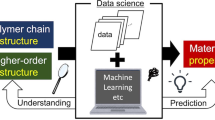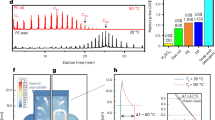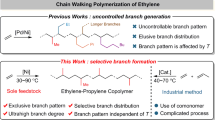Abstract
A method is described that can predict the way the great majority of polyolefins mix with each other just based on knowledge of their chemical architecture. The miscibility of saturated hydrocarbon polymers (polyolefins) is shown to be essentially controlled by the values of their solubility parameters as determined by several kinds of measurements, but most importantly from neutron scattering. Moreover, the way that these solubility parameters depend on the chain dimensions of the chains, is outlined. A method to estimate chain dimensions by a correlation of the fraction of carbons that are on side branches vs the backbone is also given. The combination of these relations thus provides a very powerful mechanism to predict the mixing thermodynamics of polyolefins blends based simply on their chemical structure.
Similar content being viewed by others
Log in or create a free account to read this content
Gain free access to this article, as well as selected content from this journal and more on nature.com
or
References
Lohse, D. J. in Applied Polymer Science—21st Century (eds Craver C. D. & Carraher C. W.) Ch. 6, 73–91 (Elsevier, 2000).
Lohse, D. J. & Graessley, W. W. in Polymer Blends: Formulation and Performance (eds Paul D. R. & Bucknall C. B. ) Vol. 1 Ch. 8, 219–237 (Wiley, New York, 2000).
Milner, S. T. & Witten, T. A. Bending moduli of polymeric surfactant interfaces. J. Phys. France 49, 1951–1962 (1988).
Schweizer, K. S. & Singh, C. Microscopic solubility-parameter theory of polymer blends: general predictions. Macromolecules 28, 2063–2080 (1995).
Crist, B. & Hill, M. J. Recent developments in phase separation of polyolefin melt blends. J. Polym. Sci. Phys. 35, 2329–2353 (1997).
Hildebrand, J. H. & Scott, R. L. The Solubility of Non-Electrolytes 3rd edn (Van Nostrand-Reinhold, Princeton, 1950; reprinted Dover Press, New York, 1964).
Krishnamoorti, R., Graessley, W. W., Fetters, L. J., Garner, R. T. & Lohse, D. J. Anomalous mixing behavior of polyisobutylene with polyolefins. Macromolecules 28, 1252–1259 (1995).
Reichart, G. C., Graessley, W. W., Register, R. A., Krishnamoorti, R. & Lohse, D. J. Anomalous attractive interactions in polypropylene blends. Macromolecules 30, 3036–3041 (1997).
Wignall, G. D., Child, H. R. & Samuels, R. J. Structural characterization of semicrystalline polymer blends by small-angle neutron scattering. Polymer 23, 957–964 (1982).
Lohse, D. J. The melt compatibility of blends of polypropylene and ethylene-propylene copolymers. Polym. Eng. Sci. 26, 1500–1509 (1986).
Nicholson, J. C., Finerman, T. M. & Crist, B. Thermodynamics of polyolefin blends: small-angle neutron scattering studies with partially deuterated chains. Polymer 31, 2287–2293 (1990).
Rhee, J. & Crist, B. Thermodynamics and phase separation in melt blends of polyethylene and model copolymers. Macromolecules 24, 5663–5669 (1991).
Balsara, N. P., Fetters, L. J., Hadjichristidis, N., Lohse, D. J., Han, C. C., Graessley, W. W. & Krishnamoorti, R. Thermodynamic interactions in model polyolefin blends obtained by small angle neutron scattering. Macromolecules 25, 6137–6147 (1992).
Krishnamoorti, R., Graessley, W. W., Balsara, N. P. & Lohse, D. J. The structural origin of thermodynamic interactions in blends of saturated hydrocarbon polymers. Macromolecules 27, 3073–3081 (1994).
Graessley, W. W., Krishnamoorti, R., Reichart, G. C., Balsara, N. P., Fetters, L. J. & Lohse, D. J. Regular and irregular mixing in blends of saturated hydrocarbon polymers. Macromolecules 28, 1260–1270 (1995).
Rabeony, M., Lohse, D. J., Garner, R. T., Han, S. J., Graessley, W. W. & Migler, K. B. Effect of pressure on polymer blend miscibility: a temperature-pressure superposition. Macromolecules 31, 6511–6514 (1998).
Alamo, R. G., Londono, J. D., Mandelkern, L., Stehling, F. C. & Wignall, G. D. Phase behavior of blends of linear and branched polyethylenes in the molten and solid states by small-angle-neutron scattering. Macromolecules 27, 411–417 (1994).
Schipp, C., Hill, M. J., Barham, P. J., Cloke, V. M., Higgins, J. S. & Oiarzabal, L. Ambiguities in the interpretation of small-angle neutron scattering from blends of linear and branched polyethylene. Polymer 37, 2291–2297 (1996).
Alamo, R. G., Graessley, W. W., Krishnamoorti, R., Lohse, D. J., Londono, J. D., Mandelkern, L., Stehling, F. C. & Wignall, G. D. SANS investigations of melt miscibility and phase segregation in blends of linear and branched polyethylenes as a function of branch content. Macromolecules 30, 561–566 (1997).
Seki, M., Nakano, H., Yamauchi, S., Suzuki, J. & Matsushita, Y. Miscibility of isotactic polypropylene/ethylene-propylene random copolymer binary blends. Macromolecules 32, 3227–3234 (1999).
Steiner, U., Klein, J. & Fetters, L. J. Surface phase inversion in finite-sized binary mixtures. Phys. Rev. Lett. 72, 1498–1501 (1994).
Scheffold, F., Eiser, E., Budkowski, A., Steiner, U., Klein, J. & Fetters, L. J. Surface phase behavior in binary polymer mixtures. I. Miscibility, phase coexistence, and interactions in polyolefin blends. J. Chem. Phys. 104, 8786–8794 (1996).
Kyu, T., Hu, S. & Stein, R. S. Characterization and properties of polyethylene blends II. Linear low-density with conventional low-density polyethylene. J. Polym. Sci. Phys. 25, 89–103 (1987).
Song, H. H., Wu, E. Q., Chu, B., Satkowski, M., Ree, M., Stein, R. S. & Phillips, J. C. Time-resolved small-angle X-ray scattering of a high density polyethylene/low density polyethylene blend. Macromolecules 23, 2380–2384 (1990).
Inaba, N., Sato, K., Suzuki, S. & Hashimoto, T. Morphology control of binary polymer mixtures by spinodal decomposition and crystallization. 1. Principle of method and preliminary results on PP/EPR. Macromolecules 19, 1690–1695 (1986).
Chen, C. -Y., Yunus, W. M. Z. W., Chiu, H. -W. & Kyu, T. Phase separation behaviour in blends of isotactic polypropylene and ethylene propylene diene terpolymer. Polymer 38, 4433–4438 (1997).
Lohse, D. J., Fetters, L. J., Doyle, M. J., Wang, H. C. & Kow, C. Miscibility in blends of model polyolefins and corresponding diblock copolymers: thermal analysis studies. Macromolecules 26, 3444–3447 (1993).
White, J. L. & Lohse, D. J. Spin diffusion analysis of miscibility in an anomalous nonpolar blend. Macromolecules 32, 958–960 (1999).
Wolak, J. E. & White, J. L. Factors that allow polyolefins to form miscible blends: polyisobutylene and head-to-head polypropylene. Macromolecules 38, 10466 (2005).
Krishnamoorti, R., Graessley, W. W., Dee, G. T., Walsh, D. J., Fetters, L. J. & Lohse, D. J. Pure component properties and mixing behavior in polyolefin blends. Macromolecules 29, 367–376 (1996).
Han, S. J., Lohse, D. J., Condo, P. D. & Sperling, L. H. Pressure-volume-temperature properties of polyolefin liquids and their melt miscibility. J. Polym. Sci. Phys. 37, 2835–2844 (1999).
Dadmun, M. D. in Encyclopedia of Polymer Science and Engineering (ed. Kroschwitz J. I.), Vol. 10, 502–524 (Wiley 2010).
Allen, G., Gee, G. & Wilson, G. J. Intermolecular forces and chain flexibilities in polymers: I. Internal pressures and cohesive energy densities of simple liquids. Polymer 1, 456–466 (1960).
Paul, D. R. & Bucknall, C. B. Polymer Blends: Formulation and Performance, (Wiley, New York, 2000).
Huggins, M. L. Solutions of long chain compunds. J. Chem. Phys. 9, 440–440 (1941).
Flory, P. J. Thermodynamics of high polymer solutions. J. Chem. Phys. 9, 660–662 (1941).
Staverman, A. J. & van Santen, J. H. The entropy of liquid mixtures. Recl. Trav. Chim. 60, 640–652 (1941).
Bensason, S., Nazarenko, S., Chum, S., Hiltner, A. & Baer, E. Blends of homogeneous ethylene-octene copolymers. Polymer 38, 3513–3520 (1997).
Yamaguchi, M., Miyata, H. & Nitta, K.-H. Compatibility of binary blends of polypropylene with ethylene-α-olefin copolymer. J. Appl. Polym. Sci. 62, 87–97 (1996).
Stephens, C. H., Hiltner, A. & Baer, E. Phase behavior of partially miscible blends of linear and branched polyethylenes. Macromolecules 36, 2733–2741 (2003).
Kamdar, A. R., Hu, Y. S., Ansems, P., Chum, S. P., Hiltner, A. & Baer, E. Miscibility of propylene-ethylene copolymer blends. Macromolecules 39, 1496–1506 (2006).
Helfand, E. & Sapse, A. M. Theory of unsymmetric polymer-polymer interfaces. J. Chem. Phys. 62, 1327–1335 (1975).
Fetters, L. J., Lohse, D. J., Richter, D., Witten, T. A. & Zirkel, A. The connection between polymer chain packing length and melt viscoelastic properties. Macromolecules 27, 4639–4647 (1994).
Flory, P. J. Statistical Mechanics of Chain Molecules, (Interscience, New York, 1969).
Fetters, L. J., Lohse, D. J., García-Franco, C. A., Brant, P. & Richter, D. Prediction of melt state polyolefin rheological properties: the unsuspected role of the average molecular weight per backbone bond. Macromolecules 35, 10096–10101 (2002).
Bates, F. S. & Fredrickson, G. H. Conformational asymmetry and polymer-polymer thermodynamics. Macromolecules 27, 1065–1067 (1994).
Fredrickson, G. H., Liu, A. J. & Bates, F. S. Entropic corrections to the flory-huggins theory of polymer blends: architectural and conformational effects. Macromolecules 27, 2503–2511 (1994).
Maranas, J. K., Mondello, M., Grest, G. S., Kumar, S. K., Debenedetti, P. G. & Graessley, W. W. Liquid structure, thermodynamics, and mixing behavior of saturated hydrocarbon polymers. 1. cohesive energy density and internal pressure. Macromolecules 31, 6991–6997 (1998).
Bates, F. S., Fetters, L. J. & Wignall, G. D. Thermodynamics of isotopic polymer mixtures: poly(vinylethylene) and poly(ethylethylene). Macromolecules 21, 1086–1094 (1988).
Acknowledgements
The research described in this paper is the result of a long collaboration with many scientists, both in ExxonMobil and also in other institutions. I acknowledge the very productive and collegial long-term interactions that formed the basis for this work, most especially with Bill Graessley, Nitash Balsara, Ramanan Krishnamoorti and Glenn Reichart. Much useful input came from discussions with Scott Milner, Buckley Crist, Lew Fetters, Ferd Stehling, Frank Bates, Joon Han, Richard Garner, Manese Rabeony and Jacob Klein. I must also recognize the input and support of Charles Han and Charlie Glinka of the National Institute of Standards and Technology and George Wignall of Oak Ridge National Lab, who also were instrumental in providing access to the neutron facilities at their respective institutions.
Author information
Authors and Affiliations
Corresponding author
Rights and permissions
About this article
Cite this article
Lohse, D. The application of neutron scattering to the relation between chain dimensions and miscibility for polyolefins. Polym J 45, 20–25 (2013). https://doi.org/10.1038/pj.2012.191
Received:
Accepted:
Published:
Issue date:
DOI: https://doi.org/10.1038/pj.2012.191



